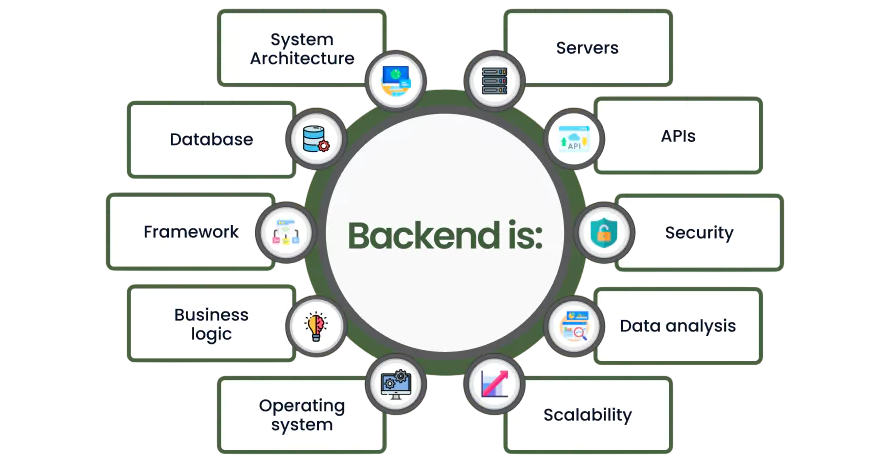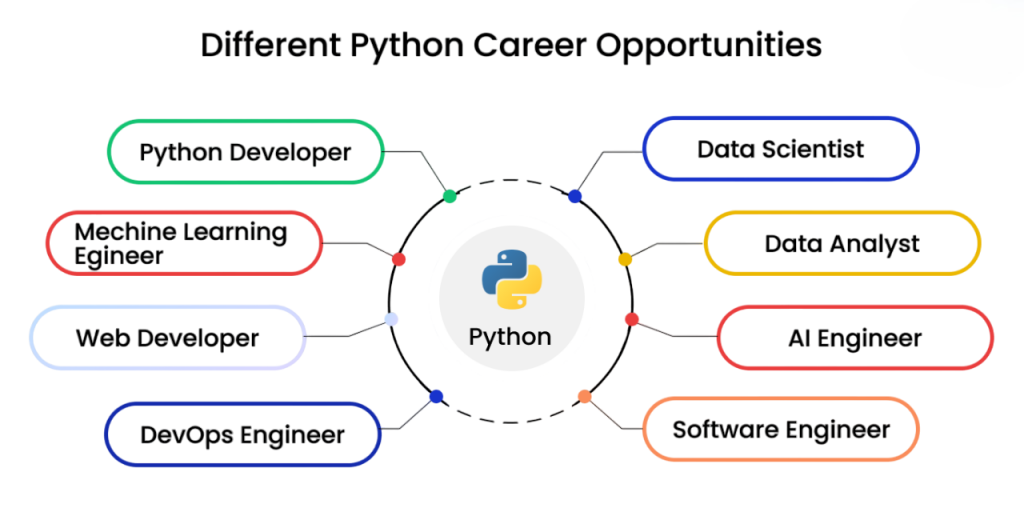
- Language Overview
- Syntax and Structure Comparison
- Use Cases (Web, Data, etc.)
- Performance and Speed
- Learning Curve
- Community and Libraries
- Backend vs Frontend Usage
- Frameworks (Django vs React/Node)
- Career Opportunities
- Ecosystem Tools
- Scalability and Flexibility
- Conclusion
Language Overview
When selecting a programming language for development, the choice often boils down to two popular options: Python vs JavaScript. Python, created in 1991 by Guido van Rossum, is known for its readability, versatility, and extensive use in data science, automation, artificial intelligence (AI), and web development. JavaScript, introduced in 1995 by Brendan Eich, is essential for creating dynamic web applications and is supported by all modern web browsers an enduring technology emphasized in Web Designing Training, where learners explore how JavaScript powers interactivity, DOM manipulation, and client-side logic. Its universal browser support and event-driven architecture make it a cornerstone of responsive, user-centric web development. Comparing Python vs JavaScript helps developers understand which language best suits their project requirements, whether for backend, frontend, or full-stack development. These two languages cater to different but often overlapping domains, making the debate of Python vs JavaScript crucial for informed decision-making in software development.
To Earn Your Web Developer Certification, Gain Insights From Leading Data Science Experts And Advance Your Career With ACTE’s Web Developer Courses Today!
Syntax and Structure Comparison
Python has a clean, readable syntax that emphasizes code readability and reduces the cost of program maintenance. It uses indentation to define blocks of code, which enhances clarity principles echoed in Understanding Body Parser in Express.js, where developers learn how structured middleware improves request handling in Node.js. Just as Python enforces clarity through indentation, Express.js promotes maintainable backend logic through modular parsing and clean routing practices.
- if x > 10:
- print(“Greater than 10”)
JavaScript, on the other hand, uses curly braces {} to define code blocks and semicolons to end statements. Its syntax is influenced by Java and is somewhat more complex:
- if (x > 10) {
- console.log(“Greater than 10”);
- }
While Python is often favored for beginners due to its straightforward syntax, JavaScript requires understanding of browser-specific APIs and asynchronous programming patterns, which can steepen the learning curve.
Use Cases (Web, Data, etc.)
Python excels in scientific computing, data analysis, machine learning, and scripting. Libraries like Pandas, NumPy, TensorFlow, and Scikit-learn make it a top choice in the data-driven domains. JavaScript is the cornerstone of web development. It’s used for both client-side and server-side programming (with Node.js). JavaScript frameworks like React, Angular, and Vue have revolutionized frontend development, while backend development with Node.js continues to grow an ecosystem contrast explored in What is an HTML Iframe, where learners discover how embedded content can enhance modular web architecture. Understanding iframe behavior alongside modern scripting languages helps developers build dynamic, interactive, and scalable web applications. In short:
- Python: Data Science, AI/ML, Automation, Web Backends.
- JavaScript: Frontend Development, Full-Stack Web Apps, Real-time Applications.
Performance and Speed
JavaScript generally offers better performance in web applications due to its event-driven, non-blocking I/O model powered by Node.js. V8, the JavaScript engine developed by Google, is highly optimized for speed. Python, being an interpreted language, is relatively slower especially for CPU-bound tasks or real-time applications. However, as explored in Web Designing Training, developers can optimize performance using tools like Cython, PyPy, and multiprocessing. While Python excels in readability and rapid development, understanding its execution model and applying best practices ensures responsive, scalable web solutions even in demanding environments. However, for CPU-intensive tasks in data analysis or AI, it leverages C-based libraries that boost performance. In real-time applications like chat systems or gaming, JavaScript outperforms Python. Conversely, in AI and data analysis, Python remains superior due to its ecosystem.
Would You Like to Know More About Web Developer? Sign Up For Our Web Developer Courses Now!
Learning Curve
Python’s syntax is often described as intuitive, making it ideal for beginners and non-programmers such as scientists or analysts. JavaScript’s learning curve is moderate to steep. While the basics are easy to pick up, mastering asynchronous behavior (callbacks, promises, async/await) and understanding the DOM, event loop, and closures requires more effort an essential challenge explored in MEAN vs MERN Stack Development, where learners compare how Angular and React handle component logic, data flow, and asynchronous operations. Understanding these core JavaScript concepts is critical for building scalable, responsive applications across both stacks. In educational settings, Python is frequently the first language taught due to its simplicity. However, web development bootcamps often start with HTML, CSS, and JavaScript due to immediate visual feedback.
Community and Libraries
Both languages boast vast and active communities. Python has a strong presence in academia and research, while JavaScript dominates in web development communities. Python’s PyPI repository hosts over 350,000 packages. JavaScript’s npm registry is even larger, with over 1.5 million packages an expansive ecosystem highlighted in Mastering Full Stack Development, where learners explore how tools like npm streamline dependency management, module reuse, and rapid prototyping across both frontend and backend layers. Understanding how to navigate and leverage this registry is essential for building scalable, maintainable full-stack applications. Both ecosystems are mature and well-supported. Community support means extensive documentation, tutorials, forums, and open-source projects are readily available for both languages.
Are You Interested in Learning More About Web Developer? Sign Up For Our Web Developer Courses Today!
Backend vs Frontend Usage
- Frontend: JavaScript is indispensable. No other language is as tightly integrated with web browsers. Modern frontend frameworks like React, Angular, and Vue are all JavaScript-based.
- Backend: Python is widely used in back-end development through frameworks like Django and Flask. It is preferred for rapid development, prototyping, and data-heavy applications.
- Full-Stack: JavaScript, through Node.js, allows for full-stack JavaScript applications, reducing context-switching and enabling developers to use one language across the entire stack.

Frameworks (Django vs React/Node)
Python:
- Django: A high-level framework that emphasizes rapid development and clean design.
- Flask: Lightweight and flexible, suitable for small applications and microservices.
JavaScript:
- React: A library (often called a framework) for building dynamic user interfaces.
- Node.js: A runtime environment that allows JavaScript to run on the server.
- Express.js: A minimal and flexible Node.js web application framework.
Django includes everything out-of-the-box, including ORM, admin panel, and authentication. JavaScript frameworks are modular, requiring more setup but offering flexibility.
Career Opportunities
Python developers are in high demand for roles in data science, machine learning, web development, automation, and DevOps. Job titles include Data Scientist, Backend Developer, Machine Learning Engineer, and SRE.

JavaScript developers dominate the web development space. Roles like Frontend Developer, Full Stack Developer, and JavaScript Engineer are common and abundant. Full-stack development is especially lucrative for those who master both frontend JavaScript frameworks and backend Python/Node.js frameworks.
Ecosystem Tools
Python:
- Jupyter Notebooks for interactive coding
- Anaconda for scientific computing
- Pipenv and Poetry for dependency management
JavaScript:
- Visual Studio Code (VS Code) with rich extensions
- Webpack, Babel, ESLint, and Prettier for development workflow
- npm and Yarn for package management
Each language has excellent IDE and toolchain support. Python leans toward scientific and automation tools, while JavaScript’s toolset is focused on frontend and web performance an ecosystem advantage explored in Use Webpack with React JS, where developers learn to bundle assets, optimize code, and streamline development workflows using Webpack’s plugin system and React’s component architecture. This synergy enables scalable, high-performance web applications with modular build pipelines and real-time feedback.
Scalability and Flexibility
Scalability:
- Python applications can scale, especially when paired with services like AWS Lambda, Kubernetes, or using asynchronous libraries like asyncio.
- JavaScript, with Node.js, is well-suited for building scalable network applications due to its non-blocking architecture.
Flexibility:
- Python is versatile, supporting a wide range of applications from web services to AI.
- JavaScript is inherently web-centric but has expanded into desktop (Electron), mobile (React Native), and server applications.
Conclusion
Python vs JavaScript serve different yet overlapping roles in the software ecosystem. Python is the go-to language for data science, AI, and back-end development, while JavaScript is essential for frontend development and is growing steadily on the backend. Choose Python if your focus is on data-heavy applications, automation, or AI. Choose JavaScript if you are targeting web interfaces, real-time apps, or full-stack development an essential decision explored in Web Designing Training, where learners build scalable web applications using both Python (via Django) and JavaScript (via React). Understanding the strengths of each language helps developers align their tech stack with project goals, whether optimizing backend logic or crafting dynamic user interfaces. Ultimately, understanding Python vs JavaScript helps developers make informed choices, and mastery of both can significantly broaden career prospects, making developers more adaptable and competitive in the job market.



